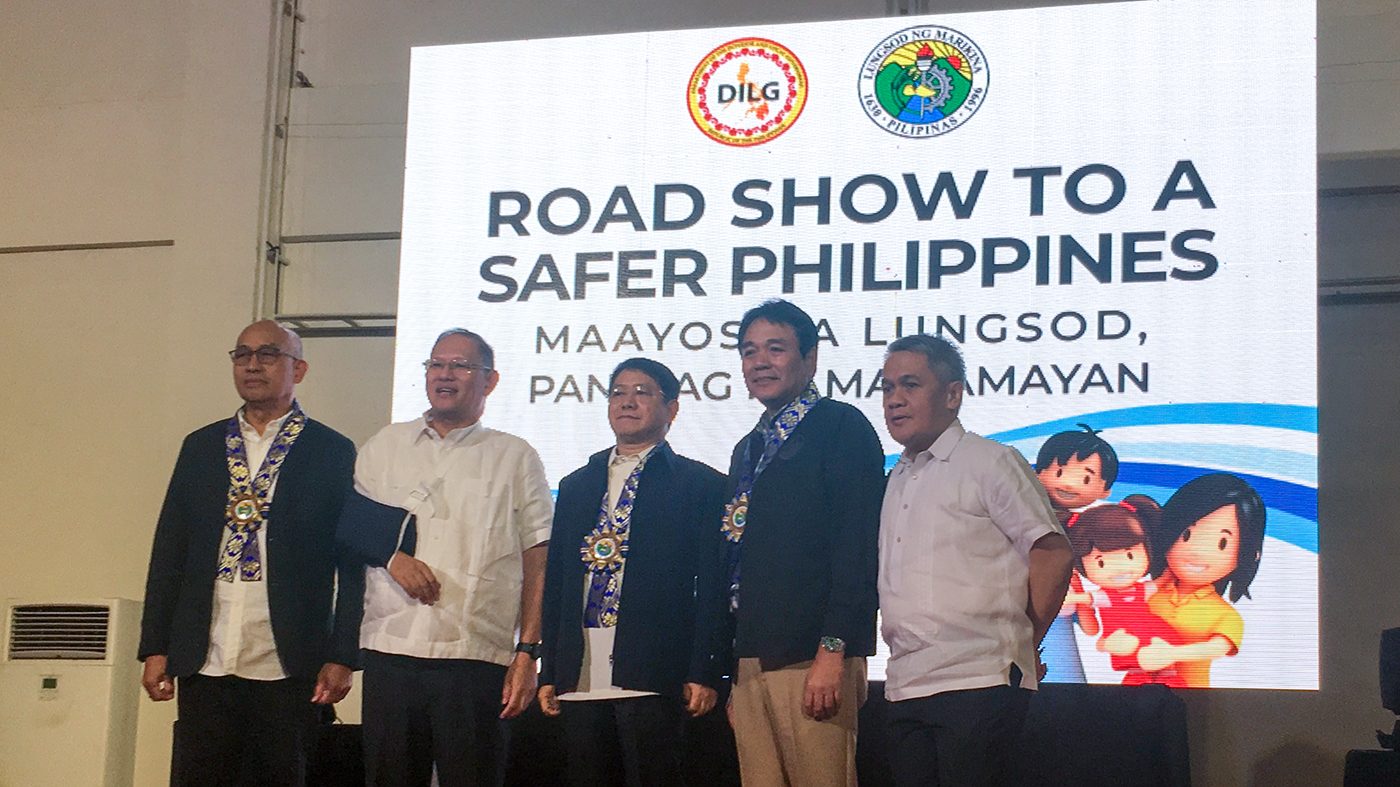SUMMARY
This is AI generated summarization, which may have errors. For context, always refer to the full article.

MANILA, Philippines – The Department of the Interior and Local Government (DILG) signed a memorandum of agreement with 5 local government units (LGUs) in Metro Manila for the Safe Philippines project, despite earlier controversy regarding its potential security risks.
The contractor of the project is the China International Telecommunication Construction Corporation (CITCC) which will provide equipment along with Huawei.
On Friday, November 22, in an ambush interview after the project’s launch in Marikina City, Interior Secretary Eduardo Año gave assurances the project will be handled by Filipinos. “They provide the equipment, and after providing the equipment, we’ll take care of this. There will be no adviser, there will be no Chinese technician, all Filipino,” he said.
P1.2 billion of the P20.31-billion project will be shouldered by the Philippine government, while the rest will be paid through a soft loan from China Eximbank, said DILG Undersecretary Jonathan Malaya.
The surveillance system project will be implemented in the cities of Marikina, Parañaque, Pasig, San Juan, and Valenzuela. Marikina will be the pilot city for the project.
Año said that the project will first be implemented in the National Capital Region and in Davao City, due to their advanced technology.
What is Safe Philippines? The project will utilize high-definition and advanced closed-circuit television (CCTV cameras) to curb crime and improve emergency response time. According to the DILG, the Safe Philippines project will enable a more efficient management of public order, safety, and security.
Around 12,000 cameras will be put up, with 234 of them to be installed in Marikina. These will be strategically located in areas where crime, traffic, floods, and fires are prevalent.
Año said the project is expected to reduce crime rate by 15% and increase response rate of law enforcers and responders by 25%. These include police and fire personnel that act during natural and human-induced emergencies.
In January 2018, Senate President Pro Tempore Ralph Recto filed a resolution to probe the surveillance system project, citing hacking and espionage allegations of Huawei, the project’s supplier.
A number of countries have already banned public procurement of equipment from Huawei, or have rejected it from developing their information and communications technology infrastructure, in view of “rising security concerns.” (READ: Why is Huawei controversial?)
How will the DILG handle its potential risk to national security? Año gave assurances that the data gathered from the surveillance system will be handled by the national government.
“Tayo ang maghahawak ng lahat ng data, tayo ang magpapatakbo, tayo ang maglalagay ng mga security protocols, pati anti-cyber warfare ano diyan. So wala tayong dapat ikabahala rito… Wala rin tayong ilalagay dito na mga classified information, kasi ito ay public safety,” Año said.
(We will handle all the data, we will run the project, we will install security protocols including those against cyber warfare. So we don’t have anything to worry about regarding this project… It will not contain classified information, because this covers public safety.)
Año added that the system is for monitoring public places. “Walang mga top secret or secret files na ilalagay didito. Ito lahat ay para masiguro na nakikita natin ‘yung community, especially public places, at madali nating masosolve ang ano mang crime na mangyayari,” Año said.
(It will not contain any top secret files. It will be used to monitor the community, especially public places, so that we can solve any crimes that can happen.)
What about the Huawei concerns? Año said that they will accord equal opportunity to Huawei, since no law bans it from the country.
“Unang-una, Huawei is one competitive company. In fact, 70% ng ginagamit natin sa Smart at Globe ay Huawei. So in our country, wala tayong ban, wala tayong batas na nagbabawal sa kanya. So we give equal opportunity to companies like Huawei,” he said.
(First of all, Huawei is one competitive company. In fact, Huawei constitues 70% of what we use for Smart and Globe. So in our country, we don’t have a ban, we don’t have a law that will prohibit it. So we give equal opportunity to companies like Huawei.)
Año ensured that, in the event of any security issue, the agency will immediately take action.
“I’ll assure you [that] we will take of security issues. If ever, let’s say for example, we detect that there is a security issue, rest assured we will do immediate action,” Año said.
What systems and equipment will be installed? Under Safe Philippines, an integrated or converged Intelligent Command, Control, and Communication Center (IC4) will be constructed, in a bid to link the National 911 Public Safety Answering Point, the DILG, the Philippine National Police, the Bureau of Fire Protection, and Bureau of Jail Management and Penology.
City-level command centers will also be established.
The first phase will utilize an advanced information and communication technology that will involve video monitoring, multimedia critical communication, information management (big data analytics), and command center systems.
With all these systems combined, Año says crimes can be prevented by using the security measures “to anticipate threats and hazardous challenges”. The project will also support post-incident examination and analysis, and coordinate follow-up actions.
What is the timeline of the project? Physical construction of the project will start in early 2020, and is targeted for completion by late 2021 or early 2022. Año said the project will be fully operational by 2022. – Rappler.com
Add a comment
How does this make you feel?
There are no comments yet. Add your comment to start the conversation.